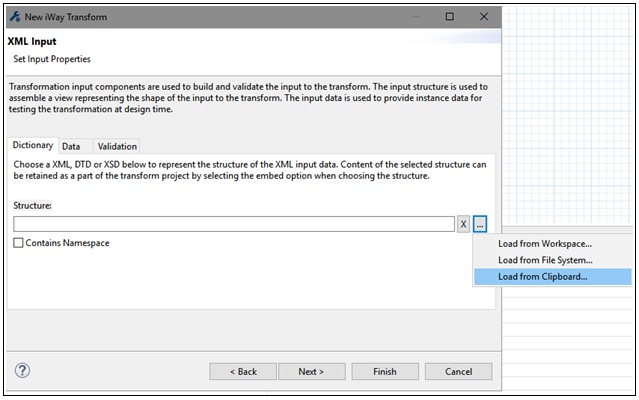New Features
|
Topics: |
This section provides a summary of new features available in iWay Service Manager (iSM) and iWay Integration Tools (iIT) in version 8.0.1. For more information, refer to the online documentation.
Blockchain Support
iSM version 8.0.1 offers integrated support for permissioned/private blockchain applications. The proven integration capabilities of iSM work with and alongside blockchain platforms, including Hyperledger Fabric and Ethereum. Using these blockchain application integration capabilities, iSM can acquire messages from the outside world, existing applications, or other sources, then process them and share the results with other applications. iSM version 8.0.1 lays the foundation for a quickly deployable, easily maintainable, service and event-oriented blockchain architecture, as well as a mechanism to make configuration easier for a user to understand.
Key Benefits:
- Reduction in development costs and time, and faster implementation into the blockchain workflow.
- Integration with peers (nodes) on the network, and the ability to transfer detailed posts and queries between peers and iSM.
- Capability for synchronous and asynchronous transaction posting to the blockchain, which directly tackles scalability, transaction speed, and throughput concerns.
- Linking multiple types of blockchains together.
- Graphical building of process flows with full integration and configuration through adapters.
- Ability to keep transactions in order, prior to posting a sequence of transactions.
- Better visibility of the workflow process with real-time exchanges of events and documents.
- Customize components through a wizard to simplify component use.
- Metadata and streaming analytics.
- Unique queries and custom event handling.
iFL Functions: _left() and _right()
This release introduces two new iWay Functional Language (iFL) functions, _left() and _right().
_left(): Leftmost Substring
The _left() function extracts the leftmost substring from an input string. It is equivalent to using the _substr() function from the left position (0), but simpler for many cases.
|
input |
string |
The string value to be operated upon. |
|
length |
integer |
Length of the substring desired. |
_right(): Rightmost Substring
The _right() function extracts the rightmost substring from an input string. It is equivalent to using the _substr() function, but avoids the need to compute the starting position.
|
input |
string |
The string value to be operated upon. |
|
length |
integer |
Length of the substring desired. |
MQ Cluster Support
This release enables an application to place a message onto the queue, which belongs to a queue manager other than the one the service is connected to, but is part of the same MQ cluster. This enables the application to communicate to a cluster rather than a singular end-point.
JSON Path Builder
iIT version 8.0.1 introduces the JSON Path Builder, which allows you to import a sample JSON-formatted document and visually build the corresponding JSON path function to retrieve a specific element. The JSON Path Builder functions similar to the previous XPath builder and is accessible from the iIT toolbar, and the Advanced variables section.
The following image shows how you can access the JSON Path Builder from the toolbar in iIT:

The following image shows how you can access the JSON Path Builder for a value using the Advanced submenu in the Run-Time Variable dialog.
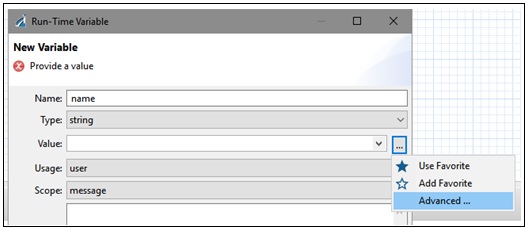
Clicking Advanced opens the Properties dialog opens. Click JsonPath Builder, as shown in the following image.
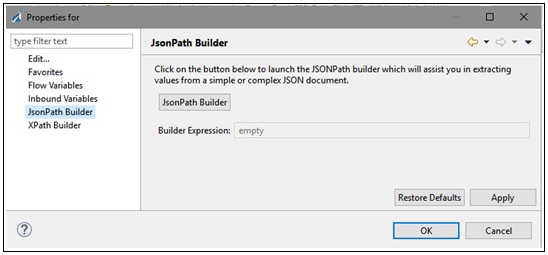
The created function can then be used as part of the parameter configuration. It is important to note that some of the services/objects take in just the JSON expression as its parameter, while others require the _jsonpath() function to be used. The JSON Path Builder is designed to provide you with assistance when creating a JSON expression.
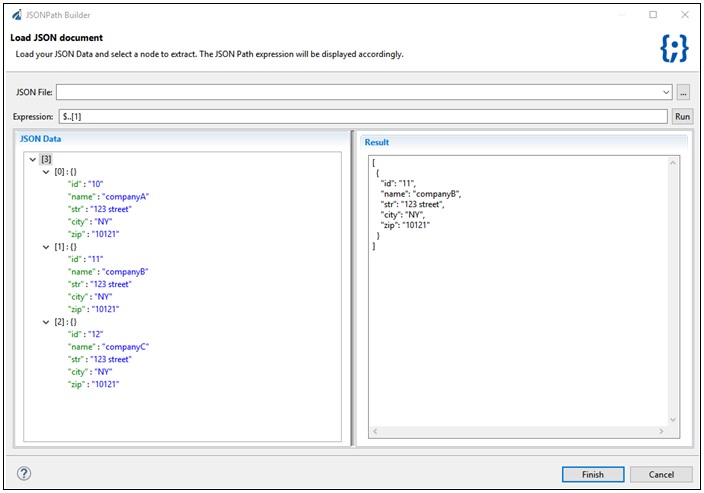
The key rule to keep in mind here is that if the object/service is working on the JSON directly (for example the JSON Iterator), then it requires just an expression as its parameter where applicable. However, if the value is to be used as part of the variable configuration, then you require an iFL function, such as _jsonpath().
Amazon Web Services Connectors: DynamoDB
iIT version 8.0.1 introduces support for the Amazon Web Services (AWS) connector for DynamoDB. This is just one of the first connectors in a series that will expose more AWS-based connectors in future releases. The DynamoDB connector can be accessed under the AWS Connectors category in the Object palette.

Internet of Things: MQTT Support
This release introduces a new Internet of Things (IoT) connector, which hosts the support for MQTT (Message Queuing Telemetry Transport) communication. It enables an application to publish a message through the MQTT protocol. This is just one of the first IoT-based supporting protocols being supported in the IoT integration series.
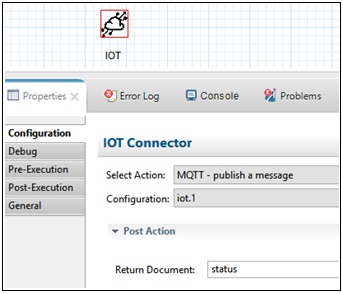
There is also a corresponding MQTT listener available for configuration in the Channel Builder. The MQTT listener enables an application to receive messages through MQTT from external systems.
Twitter Connector
This release introduces a new Twitter connector, which enables an application to integrate with social media sources. It supports an array of popular Twitter actions, such as getting and sending tweets, in addition to following and managing.
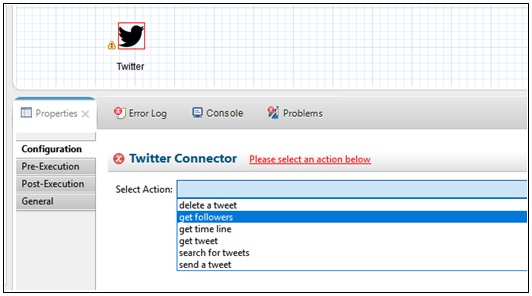
Channel Templates
This release introduces the concept of pre-loading a channel template to create a channel with a specific structure. For example, if you require a simple file-based channel, then select the template from the Template drop-down list. If you require a channel with multiple types of inputs, then you can select the corresponding template as well. The Template drop-down list can be accessed in the Channel Builder, during the creation of a new channel, as shown in the following image.
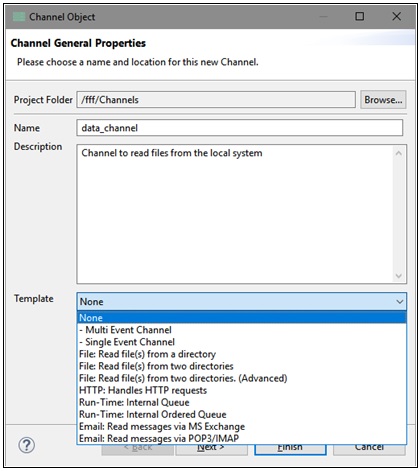
This will create a structure of the channel based on the selected channel template, and allow you to simply fill in the business logic and configuration values.
Transformer Update
The Transformer in iIT has been updated to support the test run of a transformation against a test server. This allows you to test run in Transformer similar to the way you can test run process flows. The test run facility in Transformer has also been updated to include HTTPS support for the master configuration. It is important to note that the configuration must have the proper SOAP listener enabled with SSL for the communication. This is the same approach, which has been taken for supporting HTTPS-based test runs for process flows in prior releases.
Deployment Templates
The iIT-based deployment templates have been updated to include those components which were previously available only in the iSM Administration Console. The new components include BAM and TPM configuration, Activity Facilities, Correlation Facilities and update to the security providers to be inline and reflective of all the features available in the iSM console. This should allow you to do all of your development in iIT, including template creation, without having to use the iSM Administration Console for development purposes.
If you are migrating from iWay version 8.0.0, and would like to reuse an existing Integration Project that was also created in iWay version 8.0.0, create a new template to get access to the additional components. You can also create a new Integration Project, which will enable you to create new templates.
Clipboard Support
Many components in iIT have been updated to support the loading of data files from the system clipboard in addition to loading from the workspace or file system. This enables you to simply copy and paste your data, without having to save it separately to the file system. You will notice the new option (Load from Clipboard) in many iIT components including Transformer (as shown in the following image), JSON Path Builder, and others.
